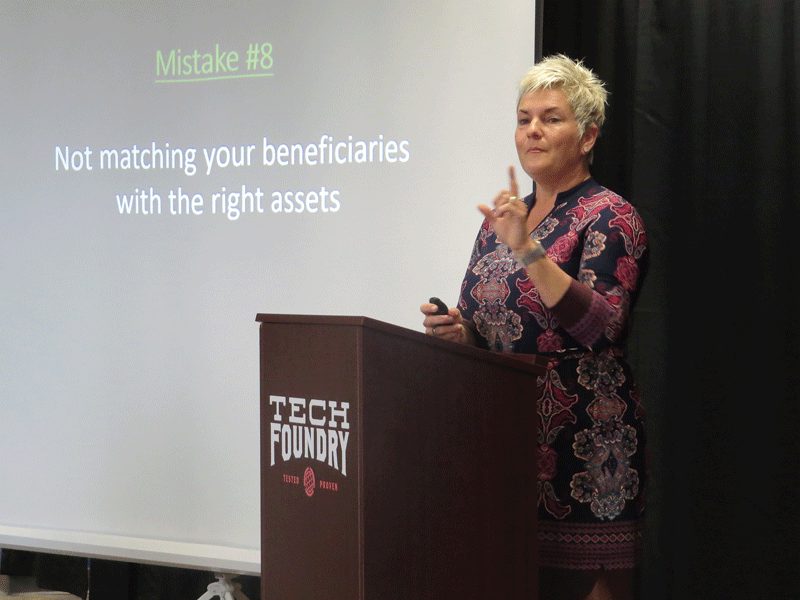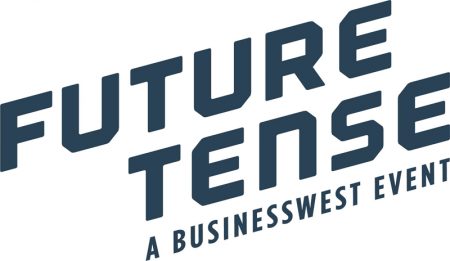Planning Can Help Eliminate Common Mistakes in Retirement
A Mindset That Pays Off

Amy Jamrog says individuals, couples, and families make many mistakes when it comes to retirement planning. The biggest, perhaps, is not starting that planning soon enough.
‘Not practicing for retirement.’
OK, that’s not one of Amy Jamrog’s official 10 ‘mistakes business owners make before and after retirement,’ but it is certainly a related topic and one worth thinking about as that day approaches.
Practice for retirement? “Yes, definitely,” said Jamrog, a financial advisor with Northwestern Mutual as she delivered the second installment in a series BusinessWest calls Future Tense on May 17 at Tech Foundry in Springfield, using that word ‘practice’ loosely to describe how individuals and especially married couples should get ready for something they’ve never experienced before and are, in most cases, not really ready for.
“Practicing retirement is a big deal,” she said, relating a story about a couple intent on retiring and moving to Cambridge. She suggested they try before they buy when it came to that concept, and they did, spending quite a bit of time in that college town.
“They loved it in the summer and hated it in the winter,” Jamrog went on. “So they’re going to split their time — keep their house here and buy a condo there; they’re not going to move there.”
The moral to the story? Prepare — for everything you can possibly prepare for.
And this brings us to those ‘official’ mistakes. They’re listed in the box on page 19, and include everything from not understanding the impact of taxes on one’s retirement to not matching beneficiaries with the right assets, to what might well be the biggest of them — not planning early enough.
And that’s just a partial list, said Jamrog, who noted that, to the casual observer, most of the points on this list seem obvious, things that most people, and certainly successful business owners, would know about and be thinking about as they progress through their career toward retirement.
But the truth of the matter is that many don’t know about such matters. And what’s worse, she told her audience, is that they think they know.
Indeed, using quite a few hypotheticals — financial advisors rely on those — but even more true but sometimes scary stories (such as the one about the owner of a $10 million business who is still using TurboTax instead of a CPA) that come in the form of conversations she’s had with her clients over the years, Jamrog drove home the point that retirement isn’t something to be entered into lightly.
And with that overriding concept, she hit many of the same chords struck by Delcie Bean, founder of Paragus Strategic IT, in the first talk in the Future Tense series, titled “An Unprecedented Technology Disruption.” Slicing through that talk, which touched on the potential impact of everything from driverless cars to artificial intelligence, Bean told his audience that, while the future is difficult if not impossible to predict, business owners must nonetheless be proactive and energetic in their efforts to prepare for what is to come — whatever that may be.
Paraphrasing considerably, Jamrog said essentially the same in her ‘10 mistakes’ talk. And that idea will be conveyed once again in September with the final talk in this series, to be presented by Meyers Brothers Kalicka.
It will be titled “Change Considerations: An Examination of Lean Process, Market Disruption, and the Future of Your Business,” and will feature Mark Borsari, president of Sanderson McLeod, who will discuss change and innovation through lean concepts, and focus on resulting cultural considerations. The program will also feature commentary from Jim Barrett, managing partner at MBK, who will address already-active market disrupters that affect business processes in various industries.
But that’s in September. First, those mistakes that business owners make before and after retirement.
Taxing Situation
To show just how common these mistakes are, Jamrog started not with a hypothetical or a conversation with a typical client, but with a reference to her own parents, who began teaching her about money and how to manage it at a very early age.
“My parents taught us to balance a checkbook, we had small stock portfolios as kids … they did a really good job teaching us about money; it’s no surprise that I ended up being a financial advisor,” she said. “But we never talked about their money; we grew up in a private, ‘it-wasn’t-polite-to-ask’ kind of household.”
Fast-forwarding a little, Jamrog said that when, at the advice of her mentor, she brought her parents in for a financial review, she was shocked at how ill-prepared the people who taught her so much about money were for the retirement that was coming up on them fast.
“My father was co-owner of PolyPlating in Chicopee; he and his business partner started the business when they were 20, they had a handshake agreement, no buy-sell agreement, nothing in writing. They hadn’t done anything with their 401(k) in 20 years, they had no life insurance for other. They basically said, ‘we’ll take care of each other if anything happens.’
“The first thing I learned about business owners from working with my parents is to not assume, just because someone looks like they’re in good shape, that they’ve got it all figured out,” she said. “They had no ducks in order at all. My dad said, ‘all I do is work; the plan is to work and then retire, so I haven’t taken any time out to see if we’re doing it right.’”
That last comment — that one about not taking the time to out to see if he was doing it right — is the keeper in this discussion, the one Jamrog wanted her audience to remember as they walked out the door.
Amy Jamrog’s 10 Retirement Mistakes
• Not having the right people on your team;
• Not applying an accumulation strategy to your distribution plan;
• Not preparing your children for the future;
• Not understanding the impact of taxes on your retirement;
• Not prepping for important age milestones: 59½, 62, 65, 70½, and 85;
• Not understand the issues inherent in your IRA;
• Not having a philanthropic plan;
• Not matching your beneficiaries with the right assets;
• Not understanding the correlations between happiness and aging (this pertains to you and your parents); and
• Not planning early enough.
Those 10 mistakes are all common, they’re all important, and they offer specific thoughts to digest. But the common denominator and the overriding assignment is to take the time to make sure you’re doing it right.
That applies to specific issues such as taxes, distribution plans, issues with individual retirement accounts, matching beneficiaries with assets, having a philanthropic plan, and much more, said Jamrog, who encouraged those in the audience to embrace issues and discussions that are often difficult for married couples to engage in and then do some hard planning.
That’s because the worst-case scenario can and often does happen, and Jamrog, sadly, can go back to her family for solid evidence. Her father died at 50 after suffering a major heart attack. Jamrog was 26 at the time, and that incident created a passion within her to work with people in their 50s, and before that, to make sure they have their ducks in a row.
“I freaked out … I started calling all my parents’ friends and asked them to come in and meet with me,” she said, adding that, when they do come in, she often sees people making some of those common mistakes because, again, they think they know what they should be doing.
That is often the case when it comes to taxes and retirement, said Jamrog, who said mistakes in this realm can have serious consequences.
Elaborating, she said retirement plans, and specifically 401(k)s, constitute the most expensive money people have in retirement, meaning they are 100% taxable.
“And yet, I see it all the time — all people want to do is pre-tax, pre-tax, pre-tax everything they’ve got,” she explained, referring to the options for those looking to put money aside. “They don’t understand that, when they get to retirement, they have a growing tax problem, a deferred tax problem. And then that’s further compounded when people think they’re going to leave that to their kids.”
That wasn’t a direct segue into some of those other common mistakes — ‘not understanding the issues inherent in your IRA’ and ‘not matching beneficiaries with the right assets’ both came several items down on the PowerPoint — but it served that role.
“The worst thing you can leave your kids, besides nothing, is a 401(k) or an IRA,” she said. “It’s the most expensive money to leave behind.”
To get that point across, she related the story of a bank president who was, that’s was, very proud that he was going to leave a $2 million IRA to his four children.
“Good news/bad news, those four children are very successful and all in high tax brackets,” Jamrog told her audience. “So if he leaves $500,000 to each of these four kids, they’ll each lose about 45% of it to taxes; they can stretch it out over their lifetime, but they’re still going to lose almost half of it in taxes.
“When he found this out, he was angry,” she went on, putting heavy emphasis on that last word. “And did not understand how he did not know that. So we came up with a plan — a $2 million life-insurance policy, which gives each of those kids $500,000 in tax-free money, plus whatever’s left in the IRA.”
This is an example of people thinking they know what to do, but in reality not knowing, said Jamrog, adding that she could fill a talk that would last several hours with such examples.
Still another common mistake, and this is related to all of those listed above, Jamrog said, is parents not doing what her parents did — compelling their children to be both informed and responsible when it comes to money.
“I have clients whose kids are in their 40s and 50s, and the parents are still prepping their taxes for them,” she said in an effort to get her point across. “They just sign their tax return and have no idea what they’re signing.
“Teach your kids how to read a tax return, introduce your kids to your accountant,” she said. “If your kid is graduating from college and getting their first job, sit down and teach them what their benefits are, show them what a 401(k) is, and encourage them to enroll in a 401(k). And if your kids don’t listen to you, introduce them to your financial advisor.”
Bottom Line
Among the many anecdotes she shared, Jamrog said one in particular probably sums up the essence of her presentation better than any other.
“I had a man in my office last week, 62 years old, say to me, ‘I’ve been meaning to meet with you for six years, but I was afraid to meet with you because I was afraid you were going to tell me I was doing it wrong, and that it would be too late,’” she said. “And I said, ‘so you waited six more years?’”
Pride, insecurity, and ego all contributed to that six-year delay, she went on, adding that, while it’s difficult to remove those factors from the equation, individuals and couples should try and put their energy into planning.
And while they’re at it, they should try practicing retirement as well.
By doing so, they may just make the future less tense.
George O’Brien can be reached at [email protected]





